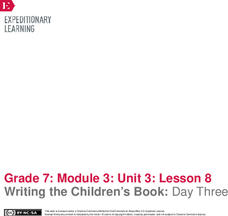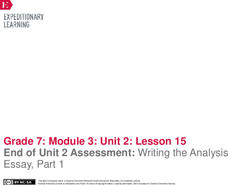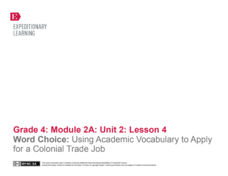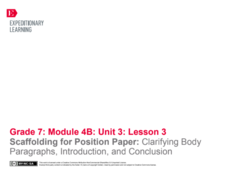Curated OER
Mystery Words
In this language arts lesson, 8th graders verify the meaning of a word in its context, even when its meaning is not directly stated. After a class discussion on how to use context clues, students pairs are given a worksheet of "mystery...
Curated OER
Imagination Or Observation?
Read the books, "Frog and Toad Are Friends," and "Tale of a Tadpole," to distinguish between fantasy and reality in the books. In this reading comprehension lesson plan, students review the similarities and differences in each book with...
Curated OER
Paul Revere's Ride
Third graders read and discuss the selection "Paul Revere's Ride" (included with the lesson). Students imagine they live in one of the villages that Paul Revere stopped. They are awakened by his knock on the door. Students write an essay...
Curated OER
Word Roots 4: GRAD, MOT, CA Advanced Word Search
Encourage your class to master vocabulary and spelling. Using clues and a word list, learners find twelve words in this word search. If you are interested, there are printouts of the directions, clues, word search, and word search answer...
Curated OER
Making a Treasure Your Own: Lesson Two
Students write an essay describing the Curtis Center and what they learned there. In this descriptive writing essay, students discuss the five paragraph essay and review sensory discoveries from their trip. Students draft an outline and...
Curated OER
Students as "Grammarians": Discovering Grammatical Rules, Lesson on Reduced Clauses of Reason
For this grammar worksheet, middle schoolers work in pairs to complete the 24 reduced clauses of reason questions. In some questions, students write answers to specific questions, and in some they fill in blanks in sentences.
Alabama Learning Exchange
Water Cycle Animation (A lesson involving handheld computer/Palm Pilots)
Fifth graders animate the Water Cycle using Sketchy on the handheld computers. They write an expository paragraph about the stages of the water cycle using "Word-to-Go" on the Handheld computers.
Curated OER
Bridges for All Lesson 1: Fighting Chance (1850-1877)
Students study how a Quaker woman, Laura Smith Haviland, served as a lifeline for fugitive and freedmen during the American Civil War era. They research other philanthropic organizations and the associate vocabulary of this era.
Curated OER
Different! Diverse! Dynamic! Lesson 1: Late Bloomers
Students examine how people grow and mature at different rates. They create a graph and a timeline to organize the data they collect.
EngageNY
Discussing and Identifying Themes: What Makes a Good Children’s Book?
Working in small groups, scholars look closely at a children's book to evaluate narrative techniques. Next, they complete a Children's Book Scavenger Hunt worksheet to analyze the literary elements of their selected stories.
EngageNY
Mid-Unit Assessment Part 2: Beginning the Writer’s Workshop
Writers learn about using sensory details as they revise bland sentences with more vivid language. Next, they begin writing the first drafts of their children's books, completing storyboards to effectively plan their writing.
EngageNY
Writing the Children’s Book: Day Three
Illustrations are a key feature of children's books. Using the resource, pupils learn about adding illustrations to their children's books. Next, as they complete their storyboards and work on their second drafts, they consider their...
EngageNY
Introducing the Process for Close Reading: Meeting Frederick Douglass
To learn more about Frederick Douglass, class members complete close reads of excerpts from Narrative of the Life of Frederick Douglass. They complete a close reading guide and questions for each excerpt. Pupils then add to the...
EngageNY
End of Unit 2 Assessment: Writing the Analysis Essay, Part 1
1,2,3,4 score! Writers use the grading rubric to score the model essay. After comparing and discussing their scorings, the individuals begin the end-of-unit assessment.
EngageNY
How Does the Author Convey Themes in Bud, Not Buddy?
After reading up to chapter 12 of Bud, Not Buddy by Christopher Paul Curtis, scholars read chapter 13 and take part in a grand conversation about the author's writing techniques. Pupils discuss how his writing conveyed literary themes...
EngageNY
Introducing “If” and Noting Notices and Wonders of the First Stanza
After reading chapter 14 of the story Bud, Not Buddy by Christopher Paul Curtis, scholars take part in a read-aloud of the poem If by Rudyard Kipling and compare it to the reading of Bud, Not Buddy. Learners then go deeper into the poem...
EngageNY
Qualities of a Strong Literary Argument Essay
One activity, two essays, and one central theme: qualities of an argument essay. Here, scholars first describe the qualities of an argument essay regarding Bud's rules to live by from the novel Bud, Not Buddy by Christopher Paul Curtis....
California Department of Education
On Tenterhooks: Analyzing the Etiology of Adolescent Anxiety
Are the joys of childhood really that joyful? Readers take a look at adolescent and young adult anxiety. Activities include close reading of articles and a self-reflection of scholars' own fears and anxiety. Learners then create a deck...
EngageNY
Word Choice: Using Academic Vocabulary to Apply for a Colonial Trade Job
Scholars reflect upon colonial jobs such as a blacksmith, cooper, shoemaker, etc. Together, the class writes a job application as a practice for working independently. Learners employ their experience in writing a job application for a...
EngageNY
Analyzing the Power of Different Mediums: Little Rock Girl 1957
Scholars begin the instructional activity by watching a video of media history and discussing it in a Turn and Talk. They then look at the texts A Mighty Long Way and Little Rock Girl 1957 to make a connection to the role of the press in...
EngageNY
Citing Evidence: The Ending of Pygmalion
Show time! After completing questions over Pygmalion section nine, scholars perform a reader's theater activity of pages 87-88. They then revisit their Eliza Character Trackers and add details as needed.
EngageNY
Gathering Information about Water Management: Assessing and Reading Internet Sources, Day 2
Accuracy, credibility, timeliness ... it's time to act on source reliability! Pupils continue conducting Internet research, selecting two questions about water management from their researcher's notebooks that they want to explore...
EngageNY
Scaffolding for Position Paper: Clarifying Body Paragraphs, Introduction, and Conclusion
Let's have a talk. Scholars talk through the body paragraphs of their Sustainable Water Management position paper with peers. They take turns explaining their work to one another. They then begin to work independently on the introduction...
EngageNY
Close Read, Part 1: “Taggot, the Blacksmith’s Daughter”
There would be no luck if it were not for bad luck. Scholars take a close look at the theme of adversity through multiple reads of Taggot, the Blacksmith’s Daughter. They place sticky notes on important details of the story and complete...
Other popular searches
- Autumn Lessons Ela
- Ela Lessons Grammar
- Spring Ela Lessons
- Biography Ela Lessons
- 4th Grade Ela Lessons
- Esl Ela Lessons
- Sequenced Ela Lessons
- Elementary Ela Lessons
- 7th Grade Ela Lessons
- 6th Grade Ela Lessons
- Ell Ela Lessons

























